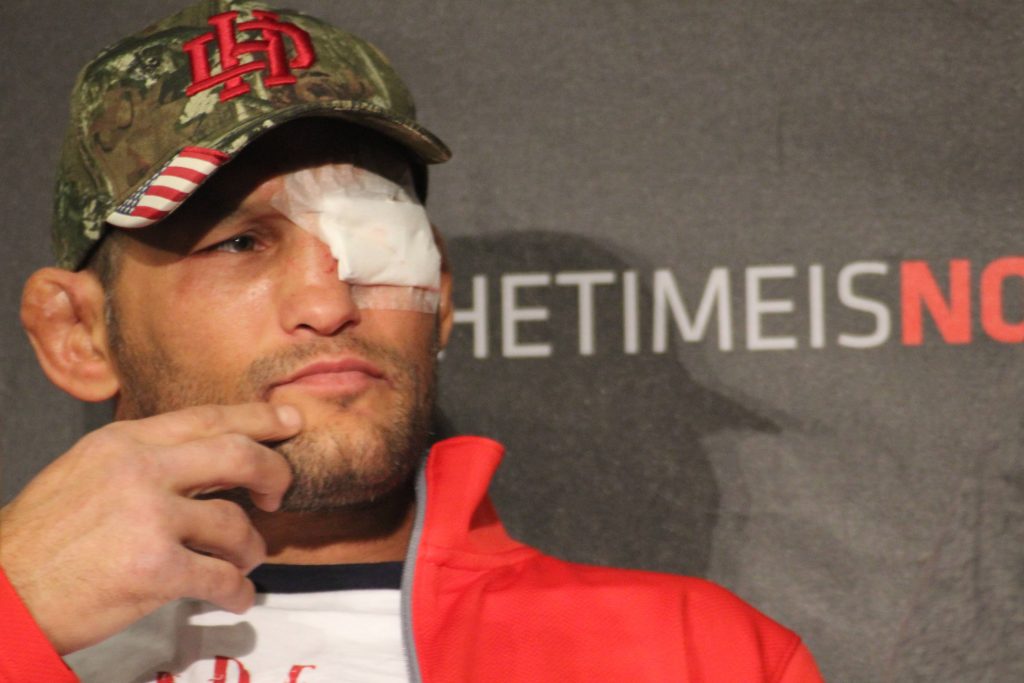Picture: UFC icon Dan Henderson at the post-fight press conference following a TKO loss to Gegard Mousasi in 2015. A legal blow caused a cut inside the veteran’s eyelid and a swift stoppage from referee Leon Roberts arguably saved the fighter from permanent damage. Following last week’s coverage of the controversy surrounding Travis Browne’s TKO victory over Matt Mitrione in their heavyweight contest at UFC Fight Night 81 (full article HERE), @IMMAFed hosted a poll on Twitter with 59% of voters choosing in favour of MMA equipment companies redesigning gloves in order to avoid further accidental eye pokes. Eye pokes seen on a number of high profile MMA shows have resulted in a variety of consequences, from momentary discomfort that is quickly recovered from, to altering or ending the course of a bout altogether. British doctor Safiyah Ahsan, a GP with special interest in sports medicine, shared insight with IMMAF.org on the dangers of eye pokes, plus eye injuries that come as a result of legal blows. Dr Ahsan highlighted the very real dangers that come with potential eye injuries. She explained how they should be addressed in the cage and in the moment of a confirmed significant injury. “There are many dangers of sustaining a punch or eye poke which can include some of the following: Retina detachment Deep eyelid laceration Sub-conjunctival haemorrhage Conjunctival laceration Corneal abrasion Acute corneal oedema Lens damage Retinal detachment “When these injuries occur it is important not touch, manipulate or pad the eye. Immediate attention should be given to the eye by a medical professional, with an adequate amount of time allowed for assessment. Any increase of pressure in the eye should be avoided and therefore the fighter must be told not to blow their nose, cough, strain or bend over. Adequate pain relief must be provided along with anti sickness if needed, and the patient must be reviewed by an eye specialist urgently.” The majority of accidental eye pokes may seem to pass without significant effects and the bout continues, although this has not always been the case in a number of high profile instances. Dr Ahsan highlighted the significant reality that many severe eye injuries can go undetected, and may even be underappreciated at first by the sufferer themselves. While the severity of the eye injury may not be immediately obvious, Dr. Ahsan warns that “where penetrating eye injuries are not suspected or diagnosed, there is real risk of a more severe outcome. “The eye should be assessed at once (by an experienced medical professional); and signs of puncture or entry wounds looked for on both aspects of the eyelids and eye itself. Other signs of penetrating injuries are poor vision, abnormal looking pupils and bleeding. The injured fighter should be assessed for pain, double vision and headaches, nausea and vomiting caused by increased pressure in the eye. “Retinal detachment is one of the more serious injuries that can occur as a result of trauma to the eye. I witnessed an eye injury at an MMA event last year whereby a fighter was accidentally poked in the eye. Due to the athlete suffering sudden visual loss and pain he was unable to continue fighting. However this was not picked up soon enough and the match continued. After the bout, due to his ongoing symptoms, the athlete attended A&E where he was referred to an eye specialist for urgent surgery and re attachment. He has been suffering from visual disturbances since this injury. This unfortunate example demonstrates the importance of careful assessment of the eye following a blow or poke. “Penetrating eye injuries can seal themselves and the signs may be difficult to detect. The incident history is crucial as it may provide the only reason to suspect such an injury. The athlete should also be asked about loss of vision, double vision and pain. An accurate report of what happened from the athlete is key: How the injury occurred and what object caused the damage will effect the degree of damage.” “The type of precautions that can be taken include, possibly, a different type of glove that may prevent future eye injuries, appropriate time out for a thorough assessment of the eyes, and checks that nails of the fighters are appropriately trimmed.” Written by IMMAF.org lead writer and website manager, Jorden Curran]]>

